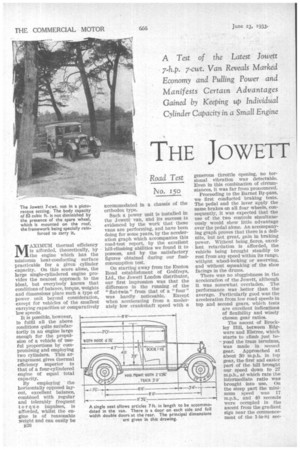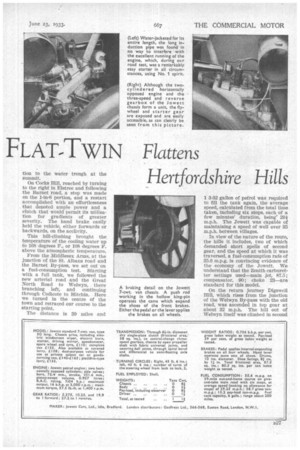THE JOWETT FLAT-TWIN Flattens
Page 40

Page 41

Page 42

If you've noticed an error in this article please click here to report it so we can fix it.
Hertfordshire Hills
MAXIMUM thermal efficiency is afforded, theoretically, by the engine which has the minimum heat-conducting surface practicable for a given cylinder capacity. On this score alone, the large single-cylindered engine provides the nearest approach to the ideal, but everybody knows that conditions of balance, torque, weights and dimensions place such a type of power unit beyond consideration, except for vehicles of the smallest carrying capacities or comparatively low speeds.
It is possible, however, to fulfil all the above conditions quite satisfactorily in an engine large enough for the propulsion of a vehicle of useful proportions by compromising and employing two cylinders. This arrangement gives thermal efficiency superior to that of a four-cylindered engine of equal total capacity.
By employing the horizontally opposed layout, excellent balance, combined with regular and tolerably frequent torque impulses, is afforded, whilst the engine is of reasonable weight and can easily be B26 accommodated in a chassis of the orthodox type.
Such a power unit is installed in the Jewett van, and its success is evidenced by the work that these vans are performing, and have been doing for some years, by the acceleration graph which accompanies this road-test report, by the excellent hill-climbing abilities we found it to possess, and by the satisfactory figures obtained during our fuelconsumption test.
On starting away from the Euston Road establishment of Godfreys, Ltd., the Jowett London distributor, our first impression was that the difference in the running of the " flat-twin " from that of a " four " was hardly noticeable. Except when accelerating from a moderately low crankshaft speed with a generous throttle opening, no torsional vibration was detectable. Even in this combination of circumstances, it was far from pronounced.
Proceeding to the Barnet By-pass, we first conducted braking tests. The pedal and the lever apply the same brakes on all four wheels, consequently, it was expected that the use of the two controls simultaneously would show little advantage over the pedal alone. An acccaripanying graph proves that there is a definite, but not great, gain in braking power. Without being fierce, excellent retardation is afforded, the vehicle being brought steadily to rest from any speed within its range, without wheel-locking or swerving, and without squeaking of the shoe facings in the drums.
There was no sluggishness in the acceleration of the Jowett, although it was somewhat overladen. The performance was better than the average. Particularly good was the acceleration from low road speeds in top and second gears, which tests are excellent indications of flexibility and wisely chosen gear ratios.
The ascent of Brockley 11111, between Edgware and Elstree, which starts to climb just beyond the tram terminus, was made in second gear. Approached at about 30 m.p.h. in top gear, the first and easier part of the hill bronght our speed down to 27 m.p.h., at which rate the intermediate ratio was brought into use. On the steep part the minimum speed was 17 --B-1 m.p.h., and 40 seconds were occupied in the ascent from the gradient sign near the commencement of the 1-in-8i see
x A i i 1
tion to the water trough at the summit.
On Cocks Hill, reached by turning to the right in Elstree and following the Barnet road, a stop was made on the 1-in-6 portion, and a restart accomplished with an effortlessness that denoted ample power and a clutch that would permit its utilization for gradients of greater severity. The hand brake easily held the vehicle, either forwards or backwards, on the acclivity.
This hill-climbing brought the temperature of the cooling water up to 168 degrees F., or 108 degrees F. above the atmospheric temperature.
From the Middlesex Arms, at the junction of the St. Albans road and the Barnet By-pass, we set out on a fuel-consumption test. Starting with a full tank, we followed the new arterial road and the Great North Road to Welwyn, there branching left, and continuing through Codicote to Hitehin. Here we turned in the centre of the town and retraced our course to the starting point.
The distance is 39 miles and 1 3-32 gallon of petrol was required to fill the tank again, the average speed, calculated from the total time taken, Including six stops, each of a few minutes' duration, being' 291 m.p.h. The Jowett was capable of maintaining a speed of well over 35 m.p.h, between villages.
In view of the nature of the route, the hills it includes, two of which demanded short spells of second gear, and the speed at which it was traversed, a fuel-consumption rate of 35.6 m.p.g. is convincing evidence of the economy of the Jowett. We understand that the Zenith carburetter settings used—main jet, 87.5; compensator, 90; choke 23—are standard for this model.
On the return journey Digswell Hill, which rises from the junction of the Welwyn By-pass with the old road, was ascended in top gear at about 32 m.p.h. The hill out of Welwyn itself was climbed in second gear at 22 m.p.h., whilst Hitchin Hill proved just too much for the Jowett in top gear, " second " having to be engaged a matter of yards before the summit.
When at the wheel, the Jowett gives the impression that one is driving a car rather than a commercial vehicle; its performance assists in this illusion, as does the comfort of the driver's seat. Light to steer, steady yet responsive to the least movement of the wheel, it is easy and pleasant to control.
The clutch, brake and accelerator are all comfortably placed and feather-light to operate. We found no difficulty in making quick and silent gear changes, and would expect any driver of average skill to be able to do the same with the minimum of practice.
A difficulty of the van designer is to accommodate the spare wheel. In this case the problem has been solved by mounting it on the roof, one of the hoop-sticks being reinforced to withstand the extra stress to which it is consequently subjected. A pair of wing-nuts, reached from the back by standing on the floor of the van, retains it in position, and it is not too heavy for a man of medium height to lift without undue effort.
Horizontal oval windows are provided in the rear doors, and give the driver a fair view of the road behind him. The one-piece windscreen is of safety glass and is capable of being raised above the driver's line of vision. A winding window is provided in each side door. The Lucas standard six-volt electrical equipment includes windscreen wiper, horn and starter. A cubby hole on the left of the instrument panel is a refinement not always found on vans, and one that is usually greatly appreciated.
Without the employment of two carburetters, a long induction pipe cannot be avoided on the horizontally opposed type of engine. On the Jowett this pipe is thoroughly water-jacketed, and, we understand, causes no trouble in starting, even in cold weather.
3328 An efficient carburetter strangler is tided, and a point which probably contributes largely to this easy starting is that the strangler is interconnected with the throttle in such a manner that, when the former is in operation, the latter is opened to precisely the right degree.
Maintenance of the engine—an Important consideration—should be extremely simple on the Jowett. The cylinder beads are detachable, giving access to the side valves—of which, of course, there are only four—so that a "top overhaul" should be a task of but a few hours. The flywheel is exposed, although the gearbox and engine form a unit, so that access to the starter gear is facilitated.
Easy to drive, designed for reliability, having a total body capacity of 83 cubic ft., and an engine that is simple, economical and of a power that has caused the bracketing of the name Jowett with hill-climbing, this van, while in our hands, proved itself to be worthy of the popularity and reputation that it already holds.




























































































